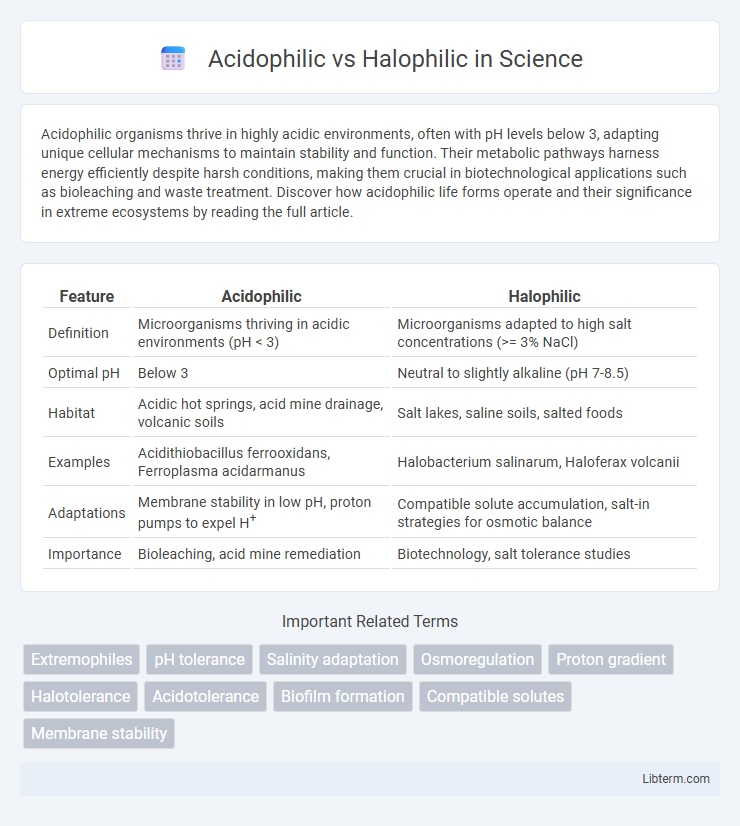Acidophilic organisms thrive in highly acidic environments, often with pH levels below 3, adapting unique cellular mechanisms to maintain stability and function. Their metabolic pathways harness energy efficiently despite harsh conditions, making them crucial in biotechnological applications such as bioleaching and waste treatment. Discover how acidophilic life forms operate and their significance in extreme ecosystems by reading the full article.
Table of Comparison
| Feature | Acidophilic | Halophilic |
|---|---|---|
| Definition | Microorganisms thriving in acidic environments (pH < 3) | Microorganisms adapted to high salt concentrations (>= 3% NaCl) |
| Optimal pH | Below 3 | Neutral to slightly alkaline (pH 7-8.5) |
| Habitat | Acidic hot springs, acid mine drainage, volcanic soils | Salt lakes, saline soils, salted foods |
| Examples | Acidithiobacillus ferrooxidans, Ferroplasma acidarmanus | Halobacterium salinarum, Haloferax volcanii |
| Adaptations | Membrane stability in low pH, proton pumps to expel H+ | Compatible solute accumulation, salt-in strategies for osmotic balance |
| Importance | Bioleaching, acid mine remediation | Biotechnology, salt tolerance studies |
Introduction to Acidophilic and Halophilic Microorganisms
Acidophilic microorganisms thrive in highly acidic environments with pH levels typically below 3, playing essential roles in bioleaching and acid mine drainage. Halophilic microorganisms require high salt concentrations, often exceeding 15% NaCl, to maintain cellular functions and are commonly found in environments such as salt lakes and saline soils. Both acidophilic and halophilic microbes exhibit specialized adaptations in their cell membrane structures and enzyme systems to survive extreme conditions.
Defining Acidophiles: Surviving in Low pH Environments
Acidophiles thrive in environments with extremely low pH levels, typically below pH 3, by maintaining internal pH homeostasis through specialized membrane adaptations and proton pumps. These microorganisms are commonly found in acidic hot springs, mine drainage sites, and sulfuric soils, where they metabolize sulfur or iron compounds to sustain energy production. Their unique enzymatic systems and protein structures provide stability and functionality under highly acidic conditions, distinguishing them from halophilic organisms that specialize in high-salinity habitats.
Halophiles Explained: Life in High-Salt Conditions
Halophiles are microorganisms that thrive in environments with extremely high salt concentrations, such as salt lakes, saline soils, and salt mines. These extremophiles have specialized cellular mechanisms, including salt-tolerant enzymes and compatible solutes, to maintain osmotic balance and protein stability in hypertonic conditions. Halophilic archaea and bacteria are key players in biotechnological applications like bioremediation and the production of salt-stable enzymes.
Key Differences: Acidophilic vs Halophilic Adaptations
Acidophilic organisms thrive in extremely low pH environments due to cellular adaptations like proton pumps and acid-stable enzymes that maintain intracellular pH balance. Halophilic organisms adapt to high-salt habitats through mechanisms such as compatible solute accumulation and specialized salt-tolerant proteins to prevent osmotic stress. These distinct biochemical and structural adaptations enable acidophiles and halophiles to survive and function optimally under acidic and saline conditions, respectively.
Structural and Biochemical Adaptations
Acidophilic organisms exhibit specialized cell membrane lipids and proton pumps that maintain cytoplasmic pH homeostasis in highly acidic environments, preventing protein denaturation and DNA damage. Halophilic microbes possess highly acidic surface proteins and accumulate compatible solutes such as potassium ions or organic osmolytes, enabling enzyme stability and cellular function in extreme salt concentrations. Both adaptations reflect evolutionary modifications at the molecular level that ensure membrane integrity and enzymatic activity under respective acidic or saline stress conditions.
Ecological Niches and Natural Habitats
Acidophilic microorganisms thrive in highly acidic environments such as acid mine drainage, sulfur springs, and acidic soils, where pH levels typically range from 1 to 5. Halophilic organisms are adapted to hypersaline habitats including salt lakes, saline soils, and salt evaporation ponds, often requiring salt concentrations above 15% for optimal growth. These distinct ecological niches reflect their specialized metabolic pathways and cellular adaptations that enable survival under extreme pH or salinity conditions.
Industrial and Biotechnological Applications
Acidophilic microorganisms thrive in low pH environments, making them valuable for bioleaching in mining industries and bio-processing of acidic waste streams. Halophilic organisms, adapted to high salt concentrations, are crucial in biotechnological applications such as enzyme production for high-salinity conditions and bioremediation of saline wastewater. Both extremophiles advance industrial processes by offering robust biocatalysts that perform efficiently under harsh environmental conditions.
Challenges in Cultivating Acidophiles and Halophiles
Cultivating acidophilic microorganisms challenges researchers due to their requirement for extremely low pH environments, necessitating specialized acid-resistant lab equipment and growth media. Halophiles demand high-salinity conditions that can corrode standard materials and complicate nutrient absorption, making it difficult to maintain stable cultures. Both acidophiles and halophiles require precise environmental controls to replicate their natural habitats, often leading to increased costs and complexity in biotechnological applications.
Evolutionary Significance and Genetic Insights
Acidophilic and halophilic microorganisms exhibit distinct evolutionary adaptations that enable survival in extreme pH and salinity environments, respectively, highlighting evolutionary divergence driven by environmental pressures. Genetic analyses reveal unique gene clusters and regulatory pathways responsible for acid tolerance in acidophiles and osmoprotection mechanisms in halophiles, underscoring specialized metabolic and structural evolution. Comparative genomics further elucidate horizontal gene transfer events and mutation rates contributing to niche-specific adaptations, providing insights into microbial evolution and potential biotechnological applications.
Future Prospects and Research Directions
Acidophilic and halophilic microorganisms present promising avenues for biotechnological innovation, particularly in bioremediation and bioenergy sectors due to their extreme environment adaptability. Future research is expected to delve into genetic and metabolic pathways to enhance industrial enzyme production and stress resistance. Advances in omics technologies will accelerate the discovery of novel biomolecules and improve synthetic biology applications tailored to acidic and saline habitats.
Acidophilic Infographic

 libterm.com
libterm.com